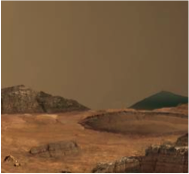- •Determine the nature and inventory of organic carbon compounds
- •Inventory the chemical building blocks of life (carbon, hydrogen, nitrogen, oxygen, phosphorous, and sulfur)
- •Identify features that may represent the effects of biological processes
- •Investigate the chemical, isotopic, and mineralogical composition of the Martian surface and near-surface geological materials
- •Interpret the processes that have formed and modified rocks and soils
- •Assess long-timescale (i.e., 4-billion-year) atmospheric evolution processes
- •Determine present state, distribution, and cycling of water and carbon dioxide
- •Characterize the broad spectrum of surface radiation, including galactic cosmic radiation, solar proton events, and secondary neutrons

CERTIFIED
The Mars Science Laboratory (Curiosity) landed at Gale Crater on Aug. 6, 2012 with the primary goal of examining Mars' environment to see if it could have supported life at some point in the past. MSL is part of a larger science strategy defined by the Mars Exploration Program, which has four primary science goals. The MSL mission itself has four mission objectives which were designed to support the Mars Exploration Program's science goals.
MSL Mission Goal
The goal of the MSL mission is to assess Mars' habitability. The following four mission objectives were designed to meet this goal.
MSL Science Objectives:
Biological objectives:
Geological and geochemical objectives:
Planetary process objectives
Surface radiation objective:
Mars Exploration Program Science Goals
The MSL mission marks the transition between the themes of "Follow the Water" and "Seek Signs of Life" in the overall Mars Exploration Program. The four main science goals of the Mars Exploration Program are listed below.
Helpful Links
Mission Description
Spacecraft Description
 PDS: The Planetary Atmospheres Node
PDS: The Planetary Atmospheres Node





